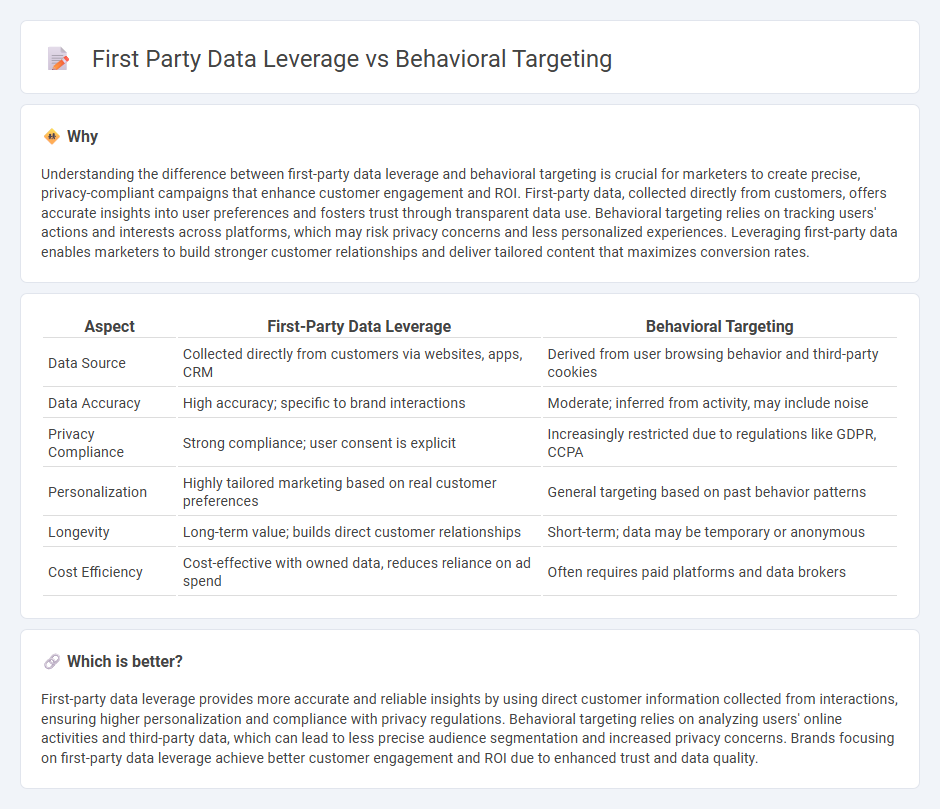
First-party data leverage empowers marketers with accurate, consented insights drawn directly from their own audience, enhancing personalized campaigns and customer loyalty. Behavioral targeting uses observed online behaviors to predict interests, but often relies on third-party cookies, raising privacy concerns. Discover how prioritizing first-party data transforms marketing strategies for better engagement and compliance.
Why it is important
Understanding the difference between first-party data leverage and behavioral targeting is crucial for marketers to create precise, privacy-compliant campaigns that enhance customer engagement and ROI. First-party data, collected directly from customers, offers accurate insights into user preferences and fosters trust through transparent data use. Behavioral targeting relies on tracking users' actions and interests across platforms, which may risk privacy concerns and less personalized experiences. Leveraging first-party data enables marketers to build stronger customer relationships and deliver tailored content that maximizes conversion rates.
Comparison Table
| Aspect | First-Party Data Leverage | Behavioral Targeting |
|---|---|---|
| Data Source | Collected directly from customers via websites, apps, CRM | Derived from user browsing behavior and third-party cookies |
| Data Accuracy | High accuracy; specific to brand interactions | Moderate; inferred from activity, may include noise |
| Privacy Compliance | Strong compliance; user consent is explicit | Increasingly restricted due to regulations like GDPR, CCPA |
| Personalization | Highly tailored marketing based on real customer preferences | General targeting based on past behavior patterns |
| Longevity | Long-term value; builds direct customer relationships | Short-term; data may be temporary or anonymous |
| Cost Efficiency | Cost-effective with owned data, reduces reliance on ad spend | Often requires paid platforms and data brokers |
Which is better?
First-party data leverage provides more accurate and reliable insights by using direct customer information collected from interactions, ensuring higher personalization and compliance with privacy regulations. Behavioral targeting relies on analyzing users' online activities and third-party data, which can lead to less precise audience segmentation and increased privacy concerns. Brands focusing on first-party data leverage achieve better customer engagement and ROI due to enhanced trust and data quality.
Connection
First-party data enables marketers to collect accurate, consented user information directly from their audience, enhancing the precision of behavioral targeting. Leveraging this data allows for personalized marketing campaigns that predict and influence consumer behavior based on past interactions and preferences. Integrating first-party data with behavioral targeting increases ROI by delivering relevant content and offers tailored to individual user journeys.
Key Terms
User Segmentation
Behavioral targeting uses user interaction data such as browsing history to create precise user segments, enhancing ad relevance and engagement. First-party data leverage relies on direct customer data collected from owned digital assets, providing more accurate, privacy-compliant segmentation based on user preferences and purchase behaviors. Explore how combining these approaches can optimize your user segmentation strategy for maximum marketing impact.
Data Privacy
Behavioral targeting relies on tracking user behavior across websites to deliver personalized ads, often raising concerns about data privacy and third-party cookie use. First-party data leverage involves using data collected directly from users by a brand, ensuring greater control and compliance with privacy regulations like GDPR and CCPA. Discover how prioritizing first-party data can enhance privacy while maintaining effective marketing strategies.
Personalization
Behavioral targeting utilizes user activity patterns to deliver tailored content, while first-party data leverage taps directly into collected customer insights for deeper personalization. Combining these strategies enhances relevance by aligning marketing efforts with individual preferences and behaviors, boosting engagement and conversion rates. Explore how integrating behavioral targeting with first-party data can revolutionize your personalization strategy.
Source and External Links
Behavioral Targeting: How It Works, Examples & Benefits - Behavioral targeting analyzes users' online activities to deliver personalized advertisements based on their browsing history and purchase patterns.
What Is Behavioral Targeting? How It Works (in 4 Steps) - This method involves collecting user data to segment audiences and deliver targeted advertising through a multi-step process.
What is Behavioral Targeting and Why It's Important - Behavioral targeting enhances relevance and improves campaign performance by analyzing user behavior to deliver personalized content and offers.
 dowidth.com
dowidth.com